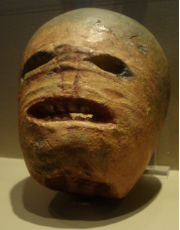Origins of Halloween
The pagan holiday Samhain.

This is an example of a Samhain turnip jack-0’-lantern.
November 7, 2022
Halloween is a holiday enjoyed by many to welcome in the colder months, but how did this holiday originate?
Originally, jack-o’-lanterns were made out of turnips, cakes were given out instead of candy, and black cats were seen as symbols of the devil.
Halloween has close ties to the traditions of the Celtic pagan holiday Samhain, which was celebrated from the sunset of Oct. 31 to the sunset of Nov. 1.
Samhain was placed “at the midpoint between the fall equinox and the winter solstice,” according to History. “During this time of year, hearth fires in family homes were left to burn out while the harvest was gathered.”
Traditional Samhain rituals involved lighting bonfires, having feasts, dancing, walking in nature, and building altars to honor ancestors. These altars commonly included apples, pumpkins, and a variety of fall crops among other items.
“Halloween pranks also have a tradition in Samhain, though in the ancient celebration, tricks were typically blamed on fairies,” according to History.
Additionally, the ties of bats to Halloween may be tied to the Samhain tradition of lighting bonfires.
“As part of Samhain, Celts lit large bonfires, which attracted insects, which in turn, attracted bats. Soon spotting bats became connected with the festival,” according to the Library of Congress.
But how did Samhain transform into modern day Halloween? Turns out, it has roots in Ireland.
“Pope Gregory III designated November 1 as a time to honor saints,” according to the Library of Congress. “Soon after, All Saints Day came to incorporate the traditions of Samhain. The evening before was known as All Hallows Eve, and later, Halloween.”
This is all due to the fact that being Pagan was gaining popularity, and Christian church leaders wanted to find a way to incorporate Samhain traditions into their religion, thus making All Saints Day and All Hallows Eve.
“As Christianity gained a foothold in Pagan communities, church leaders attempted to reframe Samhain as a Christain celebration,” according to History.
Ireland was the main country that began to transform Samhain into modern-day Halloween.
“In Ireland, mumming was the practice of putting on costumes, going door-to-door and singing songs to the dead. Cakes were given as payment,” according to History.
This has now evolved into the modern-day trick or treating.
Overall, Halloween has a dense history behind its traditions and culture. Its traditions root in an ancient holiday and will likely live on for several more generations.

